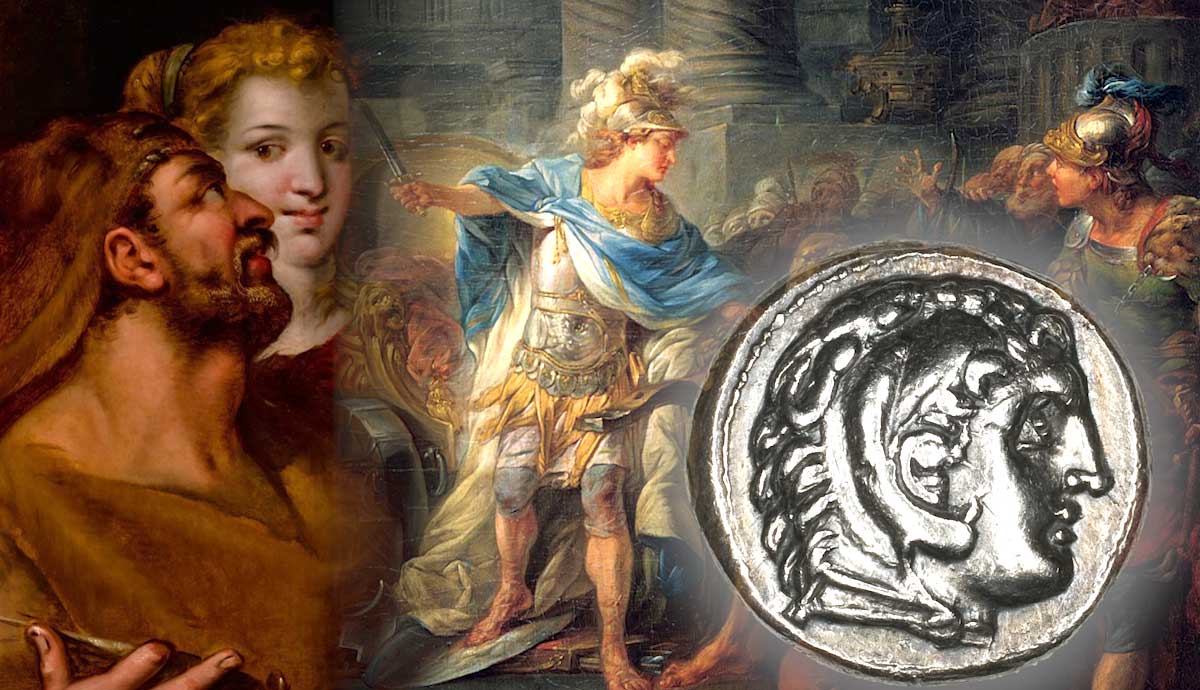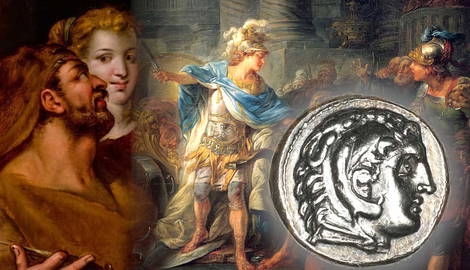
In Greek mythology, Heracles is one of the few mortals to be raised to godhood by Zeus, the king of the gods. The ancient Greeks widely considered Heracles to be the greatest of all heroes. According to ancient sources, Alexander the Great saw in Heracles an ideal he sought to emulate. The Macedonian ruler’s never-ending drive for conquest can in part be attributed to his fascination with the figure of Heracles.
The Origins of Heracles

Heracles was born from an affair Zeus had with the mortal woman Alcmene. The Goddess Hera, wife of Zeus, considered Heracles a living testimony of her husband’s transgressions. She, therefore, sent two giant snakes into Heracles’s bedchamber when he was still a child. Heracles, spotting the reptiles slithering into the room, was not afraid. He grabbed a snake in each hand and strangled them to death.
Heracles’s potential did not go unnoticed. During his youth, mentors, including Eurytus, the king of the city of Oechalia, and Abderus, the son of the god Hermes, trained him in the arts of war.

Years later, as a young man, Heracles played an instrumental role in defending his home city of Thebes. For the hero’s bravery, the local king rewarded Heracles by giving him permission to marry his daughter Megara. Heracles married the princess and they had children. For a few years, the hero lived quietly with his family.
Heracles’ peaceful period did not last long. Hera had not forgotten about him. She used her powers to induce a fit of madness in Heracles, causing him to kill his wife and children.
Overcome with sorrow and regret for slaughtering his family, Heracles set out for the oracle of Delphi. The oracle told the hero that he could atone for his sins by serving Eurystheus, the king of Tyrins, for ten years.
The Twelve Labors of Heracles

At Tyrins, Eurystheus told Heracles that he would assign him ten tasks, one for each year the hero was to be in his service.
For the next decade, Heracles slayed monsters, caught beasts, and performed miraculous feats. During his trials, Heracles received help from powerful beings, such as the goddess Athena and the sun god Helios.
Upon returning from his tenth task, Eurystheus accused Heracles of cheating and assigned him two more challenges.
The first of the final two trials saw Heracles freeing the titan Prometheus, whom Zeus had chained to a rock as punishment for introducing fire to mankind. The last one involved entering the underworld and bringing the hellhound Cerberus in front of Eurystheus. These tasks, too, were completed successfully by Heracles.
The Death and Deification of Heracles

After completing the twelve labors, adventures continued to present themselves to Heracles. One day, the mischievous centaur Nessus attacked Heracles’s wife, Deianeira (he had remarried), and Heracles shot Nessus with a poisoned arrow.
Before Nessus died, he convinced Deianeira to present Heracles with a shirt drenched in his blood. The centaur claimed that the blood had magical properties that would rekindle her relationship with Heracles. In reality, his blood had become affected by the poison of the arrow Heracles had shot him with. As soon as the hero put on the shirt, the poison began to tear through his flesh.
Heracles realized his fate and used his last strength to build a funeral pyre for himself. Zeus, witnessing his son’s passing, decided to reward Heracles for his exceptional life by making him a god, giving him a place at Olympus.
Importance of Heracles in Alexander’s Macedon

During Alexander the Great’s time, Heracles was worshipped throughout the kingdom of Macedonia as the god of bravery, military might, and physical excellence. He was also the guardian deity of the youth and hunters.
As a member of the Argead dynasty, Alexander traced his lineage back to Heracles’s alleged great-great-grandson Temenus, whose son Karanos was the mythical founder of the kingdom of Macedonia.

When Alexander became king in 336 BCE, his responsibilities included leading religious ceremonies dedicated to Heracles. Coins and sculptures of Alexander’s reign commonly depict the king wearing lionskin, in emulation of Heracles, while the hero’s symbols – the club and the arrow – also appear in the period’s coinage.
Reportedly, Alexander had an illegitimate son named Heracles, who was killed at the age of 18 in the context of succession disputes known as the Diadochi Wars.
Alexander’s Conquests

“Alexander was also partly urged by a desire of emulating Perseus and Heracles, from both of whom he traced his descent.”
Arrian, Anabasis of Alexander, 3.3
During his conquests, Alexander did not stop the practice of holding religious ceremonies in Heracles’ name.
In 335 BCE, Alexander sacrificed to the god after destroying a rebel stronghold near the Danube River. A year later, when the Macedonian king’s army crossed the Hellespont to invade the Persian Empire, he made sure to seek Heracles’s favor by once again sacrificing animals in his name.
At the battle of Issus in 335 BCE, his second large battle against the Persian Empire, Alexander told his men that:
“They would one day traverse the bounds of set by Heracles and Dionysus to subdue not only the Persians but all the races of the earth.”
Curtius, Historiae Alexandri Magni, chapter 3.10.5.
According to the ancient Greek historian Arrian, some of Alexander’s flatterers publicly compared him to Heracles, which bred resentment among other followers. Also, a companion named Anaxarchus suggested that the Macedonians should worship Alexander instead of Heracles, as only the former originated from Macedon. This prompted another companion named Callisthenes to remind Anaxarchus that even Heracles was not worshipped while he was still alive.
Heracles and the Siege of Tyre

The city of Tyre was located on a small island off the coast of current-day Lebanon. It possessed formidable walls and could only be reached by ship. Taking the city would require the most difficult siege operation of Alexander’s life.
First, Alexander ordered a bridge to be constructed to connect the mainland to Tyre. Tyrian attacks hindered the construction process, so the Macedonians used siege towers and their navy to protect the workers. The Macedonians continued building, and after many months of labor, the bridge was completed.
Shortly before he ordered the assault that would finally take Tyre, Alexander had a dream of Heracles welcoming him into the city. This experience prompted Alexander to order his men to leave untouched all Tyrians who sought refuge in the temple of Melqart, whom the Greeks associated with Heracles. Interestingly, before the siege of Tyre, Alexander had asked the Tyrians to allow him to offer sacrifices to Melqart, claiming that he would spare them and their city. It was only after the Tyrians had refused Alexander’s request that the siege began.
The day the walls fell, the Macedonian troops flooded the city. A slaughter ensued that saw almost the entire population of the city put to the spear. Alexander’s orders, however, were followed, and the citizens who had fled into the temple were spared.
Having taken possession of the city, Alexander offered sacrifices to Heracles and held a ceremonial parade in the god’s name. He also dedicated the siege ram that first breached the Tyrian walls to Heracles.
Outdoing Heracles on the Aornus Rock

Four years after the siege of Tyre, Alexander had conquered the Persian Empire and was campaigning on the Indian subcontinent.
In the mountain ranges of modern-day Pakistan, tribesmen thwarted Alexander’s advance. Unwilling to face the Macedonian army head-on, they sought refuge on a 1500-meter-high mountain, locally known as the “Āvárana Rock”.
An adventure of Heracles involved the hero laying siege to a mountain known as the Aornus Rock. The story went that an earthquake forced the hero to retreat. Locals told the Macedonians a similar story of a god, possibly Krishna, failing to capture the rock.
Alexander was not discouraged by the stories of gods failing to capture the mountain, but rather became determined to outdo Heracles.
“Alexander was seized with a vehement desire to capture this mountain also, especially on account of the legend which was current about Heracles.”
Arrian, Anabasis of Alexander, 4.30
A local with knowledge of the area, showed the Macedonians the best path to take up the steep mountain. Nonetheless, it took Alexander’s troops days to climb the rocky terrain to the top. To traverse a large chasm, they had to construct a bridge while the tribesmen pelted them with missiles and rocks from above.
After the bridge was finally in place, the Macedonians attacked the camp on the summit. Unwilling to face the charge, the tribesmen routed, allowing Alexander to take possession of the mountain.
Alexander the Great and Heracles: A New Ideal

The stories of Alexander and Heracles share many similarities. In their youth, both were mentored by the most remarkable of individuals. Aristotle was Alexander’s teacher, while Heracles had many teachers, most famously the wise centaur Chiron. Heracles completed twelve challenging tasks and then continued adventuring. Alexander conquered most of the known world and then ventured beyond its edges into India.
Heracles was rewarded for his deeds by becoming a god, whereas Alexander presented himself as a god to the peoples he conquered.
Before and during Alexander’s time, Heracles had been a revered symbol of the Macedonian Kingdom. By ending the Persian Empire and spreading Hellenism throughout Asia, Alexander became a hero around whom the Hellenistic world would revolve. As he had looked up to Heracles, rulers would look up to Alexander for centuries to come.










